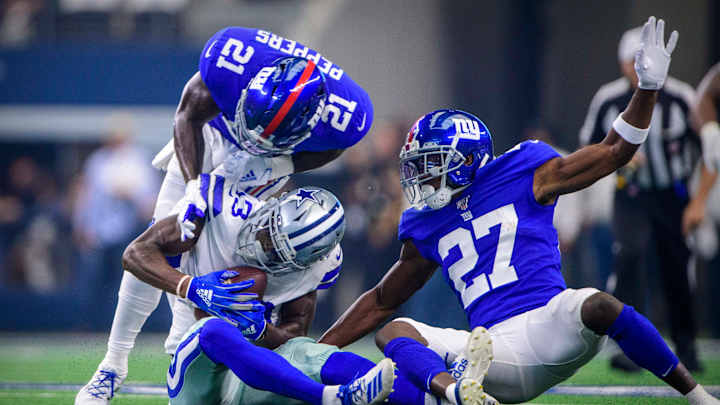Draft Suggests Backfield-first Philosophy for Giants Defense

Dave Gettleman's third NFL Draft as Giants general manager saw three defensive back selections with two in the first four rounds. That brings Gettleman's total for defensive back selections to six over the last two drafts.
Gettleman's investments in the secondary don't end with draft picks either. The Giants' biggest free-agent signing this offseason was cornerback James Bradberry, who joins a group that includes safety Jabrill Peppers, acquired in the trade package that sent receiver Odell Beckaham Jr. to Cleveland a year ago.
Even with so much capital already invested in secondary, and with much thinner depth at linebacker and edge rusher, Gettleman continued to prioritize defensive backs in this year's draft.
"We feel like we improved our team's speed, and that was what we were trying to do," Gettleman said after the draft.
Between the selection of Xavier McKinney in the second round and Darnay Holmes in the fourth, Gettleman added pieces that make the Giants' secondary one of the deepest in the league as far as young talent.
"You can never have enough DBs,” said head coach Joe Judge. “We’re putting together, I think, a very talented young group that has the ability to play football at the NFL level, but we’ve just got to get ‘em rolling."
All that speed and versatility came at the expense of any early-round reinforcements upfront.
Gettleman passed on several opportunities to add edge rushers or an extra linebacker in the first five rounds, leaving a pass rush that ranked 28th in team sacks in 2019 unaddressed until the selection of Penn State's Cam Brown with the 184th pick.
After Brown, Gettleman rounded out his day-three haul by taking three special-team hopefuls in the twilight of the draft, as none of the four linebackers selected boast intangibles to be a defensive starter in the NFL.
And like Gettleman's investments in the secondary, his disregard of the front seven goes beyond the draft. Gettleman's free-agency plan saw no pursuit of Jadeveon Clowney or Yannick Ngakoue.
The addition of Blake Martinez and Kyler Fackrell did give the Giants two experienced linebackers. Martinez fills a void left by the departure of Alec Ogletree, and Fackrell, who is now the veteran edge rusher on the Giants, is coming off a one-sack season.
Despite several chances to give his front seven a short-term and long-term boost during the draft, Gettleman stuck with stockpiling offensive linemen and defensive backs.
These decisions may indicate the football equivalent to a trickle-down economy for Gettleman and the Giants's defense. They illustrated a draft philosophy that prioritized adding wealth to an already-flushed backfield, rather than looking to balance out a lack of resources at linebacker and edge rusher.
In the post-draft press conference, Gettleman admitted that he missed out on a "blue goose pass rusher" in this year's draft, but insisted that generating pressure on quarterbacks needs to be a "group effort" by the defense.
New defensive coordinator Patrick Graham, who does run a scheme that features a diverse range of defensive-back blitzes, will have a one-sided slate of talent to work with come training camp.
Without any help in the draft, the offseason has officially made the Giants' pass-rushing personnel even weaker than it was in 2019. If Graham can't scheme up quarterback pressure with what he has, then the organization could be in for a historically-bad year in terms of sack numbers.
Either way, the Giants' hopes for any semblance of improvement on defense will be almost entirely dependent on the chemistry and development of their young secondary in 2020.
If they pull it off, it might be enough to spark a shift in defensive priorities across the NFL.
